INDUSTRIAL &
TERMINAL RAILROADS &
RAIL-MARINE OPERATIONS
OF BROOKLYN, QUEENS, STATEN
ISLAND, BRONX &
MANHATTAN:
| BUSH
TERMINAL RAILROAD Sunset Park, Brooklyn |
|
.
|
updated: |
||
|
|
||
| Bush Docks Railway passenger tickets added | 07 May 2023 | Memorabilia |
| 1903 construction images added |
08 January 2023 | Property & Facilities |
.
.

| Customer List | |||
| Memorabilia | |||
|
Bush Terminal Railroad - Locomotive, Non Revenue & Marine Equipment: Rosters & Photos |
|||
.
.
.
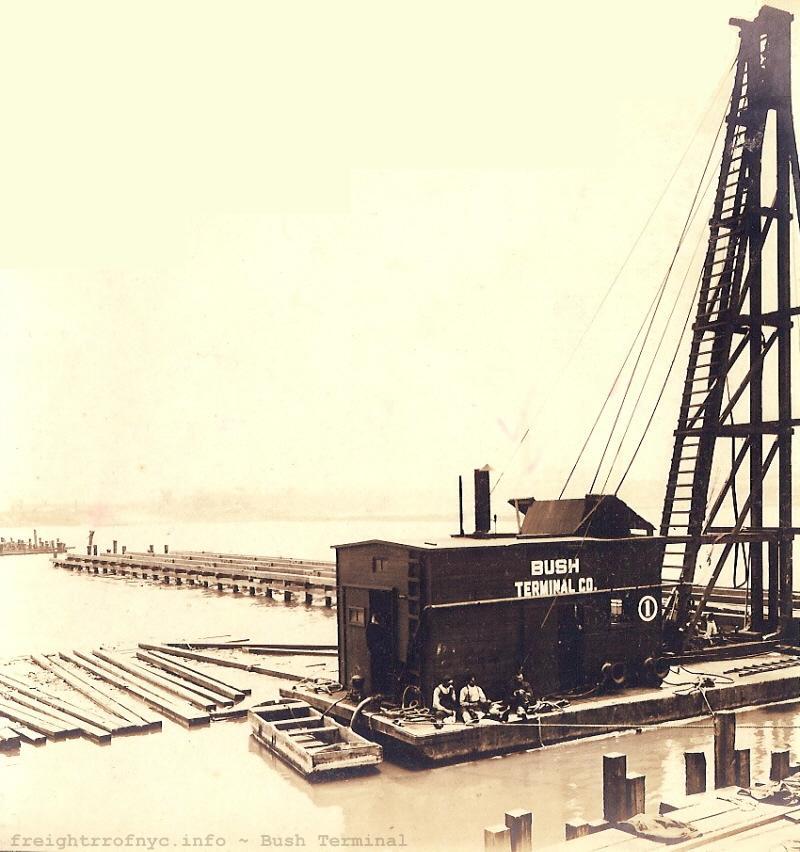
Bush Terminal Pile Driver - July 1, 1903
W. L. S. photo
authors collection
.
.
Another independent Rail-Marine contract terminal located in Brooklyn, receiving carfloats from various points of origin. But unlike most others, Bush Terminal was also a major shipment receiving and originating point (forgoing the need for carfloating) for a great deal of freight as well.
Bush Terminal was organized around the 1890's by Irving T. Bush (born July 12, 1869 - died 1948), on the site of his father's former oil business in the Sunset Park neighborhood of Brooklyn. Bush Terminal began with one pier, a warehouse and old railroad engine and one towboat. At this time, it was known as "Bush Docks" and was part of the Bush Company Limited corporation, which was owned by Irving Bush, his brother and his mother..
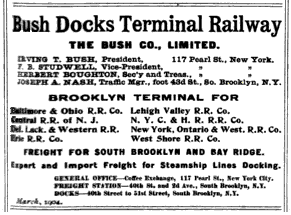
Official Railway Guide, 1905
.
Development grew steadily, and was eventually completed around 1920. The vast size of Bush Terminal allowed it to accommodate just about any industry interested in leasing space, and Bush Terminal eventually became the largest of the Brooklyn terminals with seven full sized piers (the largest in NY Harbor when constructed).
Bush Terminal constructed humongous warehouses and piers (some with indoor rail sidings), and all this were served by its own rail network and marine fleets. Most of Bush Terminal trackage would be located between 39th Street and 51st Street, but there was also a Bush Terminal Railroad yard located as far north as 28th Street.
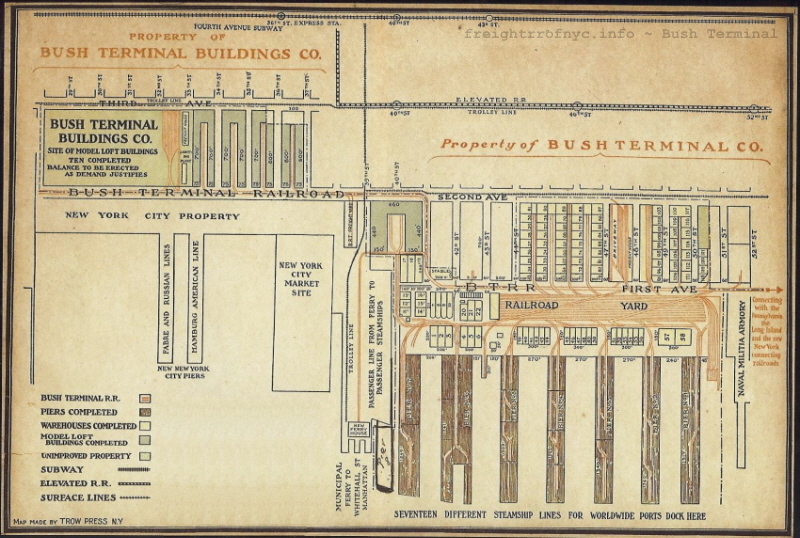
ca. 1916
In November 1947, the remains of 5200 fallen servicemen from the European Theater of Operations were repatriated to the United Stated. The ship carrying the caskets docked at the Brooklyn Army Terminal, and the caskets transferred to US Army Transportation Corps Mortuary Cars. Following the completeion of loading, the cars were brought from the Army Terminal to Bush Terminal float brdiges by a Bush Terminal locomotive and crew. Then, they wre placed onboard Bush Terminal Carfloats #44 and 41 and were floated west to Greenville, NJ.
Clicking on the following image will bring you to a collection of images once carried by Life Magazine. A link at the bottom of that page or the back arrow on your browser will return you here:
.
.
Bush Terminal would serve the New York area for the better part of eighty years, with only the Brooklyn Eastern District Terminal preceding it in operation. It would become the second of the four independent contract terminals to cease operations, (with Jay Street Terminal closing in 1959), due to the downturn of waterborne freight traffic and the completion of the interstate highway system.
In 1971, the Bush Terminal Company would file for bankruptcy and ultimately go out of business and cease operations on March 11, 1972. At this time, the City of New York purchased the Bush Terminal properties and would subsequently lease the railroad operations to New York Dock. Those customers located around and serviced at the Bush Terminal location by the New York Dock Railway, were levied a surcharge for their deliveries to help financially support the railroad operation.
New York Dock would also eventually merge with the Brooklyn Eastern District Terminal in 1978 and would operate until August 21, 1983. Two weeks later, the "New York Cross Harbor Railroad" would assume operations of the Bush Terminal area for rail operations.
Bush Terminal operations still survive today, albeit as "New York New Jersey Rail, LLC" (formerly New York Cross Harbor Railroad), and carfloats still arrive from Greenville, NJ. Only the Bush Terminal 50th Street ("Bush 2") floatbridge remains in service at this time. Sources have it that the Greenville float bridges are slated for complete replacement to handle increasing traffic flow.
.
| The vision of Bush Terminal, belonged to none other than
Irving T. Bush.
Irving T. Bush was born on July 12, 1869 in Ridgeway, Michigan; to Rufus T. and Sarah M. Bush (née Hall). Irving relocated to Brooklyn, NY with his family at a young age, and in time his father Rufus assembled a large plot of land bordering on Upper New York Harbor where he constructed an oil refinery known as Bush & Denslow Manufacturing Co. Around the middle of the 1880's, Irving's father sold this Brooklyn waterfront oil refinery to Standard Oil and retired. Upon Rufus' accidental death in 1890, the Bush estate was valued at an estimated $2,000,000 (approximately $48,822,000 in 2008 dollars). At the age of twenty-one, Irving (and at that time a clerk for Standard Oil) could have immediately retired from business and lived off his inheritance, but the family heirs quickly incorporated the estate under the name "The Bush Company". Irving became impressed with the growing congestion of business and traffic in the Port of New York, and applied himself to an urgent solution. In 1895, using this inheritance, he established several warehouses. This in turn led to his subsequent conception and construction of "Bush Terminal", a consolidated shipping and freight terminal, which integrated large covered piers (each accommodating several large ships at once), warehousing, storage, a freight railroad and eventually motor freight (trucking). It took 25 years, but upon completion; this consolidated freight terminal was such a resounding success, that Bush Terminal was recognized by many architectural and engineering studies as the "model" freight terminal for many years to come. Also as a result of his success, Irving Bush wrote many articles which were published in many well recognized business periodicals. Personal Life Irving's first marriage was to Ms. Belle Barlow on February 2, 1891, with whom he had two daughters, Beatrice born on October 10, 1895 and Eleanor, born September 20, 1898 (and of whom the two tugboats were named after). Upon divorcing Belle some years later, Irving subsequently married Maud (sometimes spelled Maude) Beard on April 20, 1907. A son was borne of this marriage and of whom was named Rufus who was born on April 24, 1908. For currently unknown reasons (but after reading the next few sentences one could easily jump to a logical conclusion), Irving secured a divorce from his second wife Maud in Reno, Nevada in 1930. |
|
| . Within an hour of this divorce, Irving married Ms. Marian Spore, who was recognized as artist, socialite, philanthropist and surprisingly, a dentist! Ms. Spore was also the sister of Commander James S. Spore, onetime Governor of Guam. Irving had met Ms. Spore in the 1920's, while working on a breadline on the Bowery in New York City. Ms. Spore coincidentally, was also born in Michigan. Not surprisingly, due to Irving's prominence in New York business circles, this divorce and rapid marriage made the front page of the New York Times among other periodicals. Marian would pass away in 1946 and upon Irving's death on October 21, 1948; Ms. Spores' niece Helen Tunison, dedicated the statue of Irving T. Bush (seen below) which is located on the facade of the Bush Terminal Building. Fortunately, the Bush Terminal office building stands to this day and in July of 2008, both Paul Strubeck and myself visited the area and took several photographs. Bush residences include: Irving T. Bush's 1905 townhouse at 28 East 64th Street, Manhattan; Mountain Lake Estates in Florida; and 280 Park Avenue, Manhattan. Other than his position of President of the Bush Terminal Company and Bush Terminal Railroad, Irving was Director of The Merchants Association of New York; Congregationalist; Member American Economic Association, Holland Society, Pan-American Society of United States, Chamber of Commerce of State of New York; and member of: Press Club, Union League, New York Yacht Club, American Yacht Club, Hamilton Club, Down Town Association, Economic of New York, Automobile Club of America, Sleepy Hollow Country Club, Knollwood Country Club, National Arts, and the Country Club of Lakewood, New Jersey.
|
|
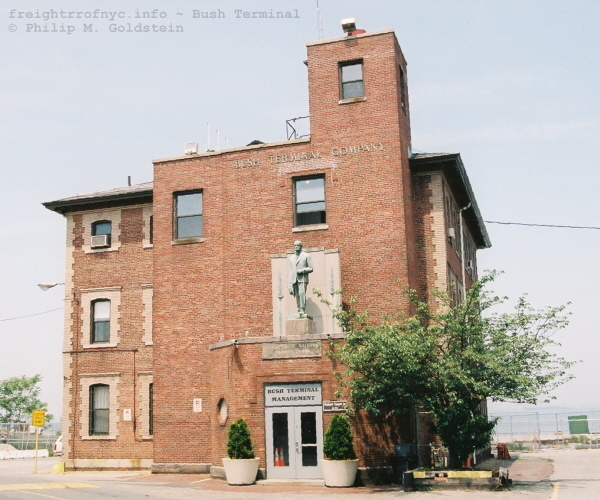 |
... | 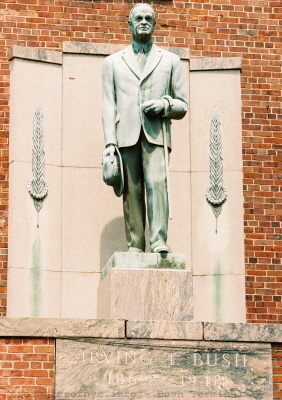 |
|
both photos:
. |
||
.
A comparison of the capacities of Bush Terminal between 1903 and 1912 were located in the "Report of the Committee on Terminals and Transportation of the New York State Food Investigating Commission" published 1913; are as follows:
|
stations |
| |. |
freight house |
| |. |
delivery track |
| |. |
storage track |
||||
|
1903 |
1913 |
| |
1903 |
1913 |
| |
1903 |
1913 |
| |
1903 |
1913 |
| . | ||||||||||
| Bush Terminal.. | Bush Terminal... | | |
10 |
80 |
| |
20 |
60 - 250.. |
| |
200 |
1500 |
Joe Roborecky forwarded the following on 17 July 2010. It is an excerpt from the "Proceedings of the Fifth Annual Convention of the American Railway Engineering and Maintenance of Way Association, March 15, 16 and 17, 1904":
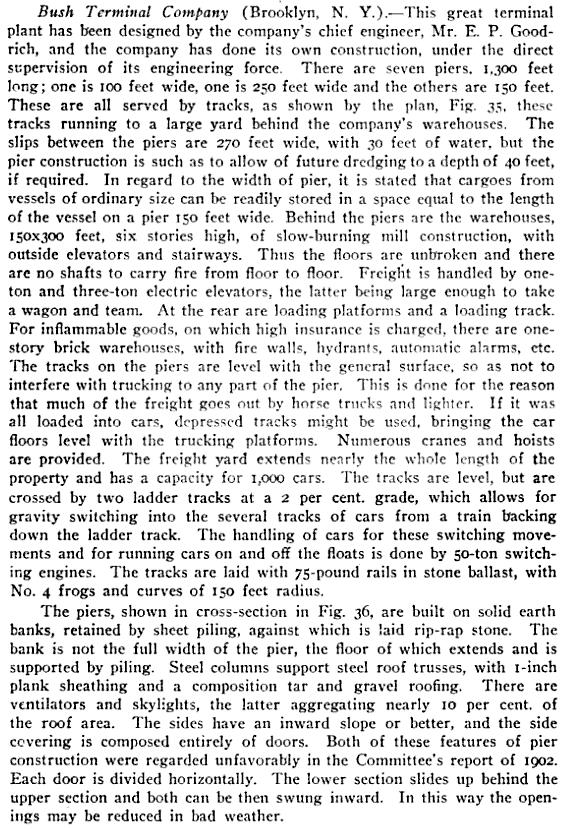
Proceedings of the Fifth Annual Convention of the
American Railway Engineering and Maintenance of Way Association, 1904
(corresponding map may be viewed in trackage chapter
below)
added 17 July 2010
..
.
The following images were located by Paul Strubeck in December of 2022. They are a record of construction taking place in early to mid 1903.
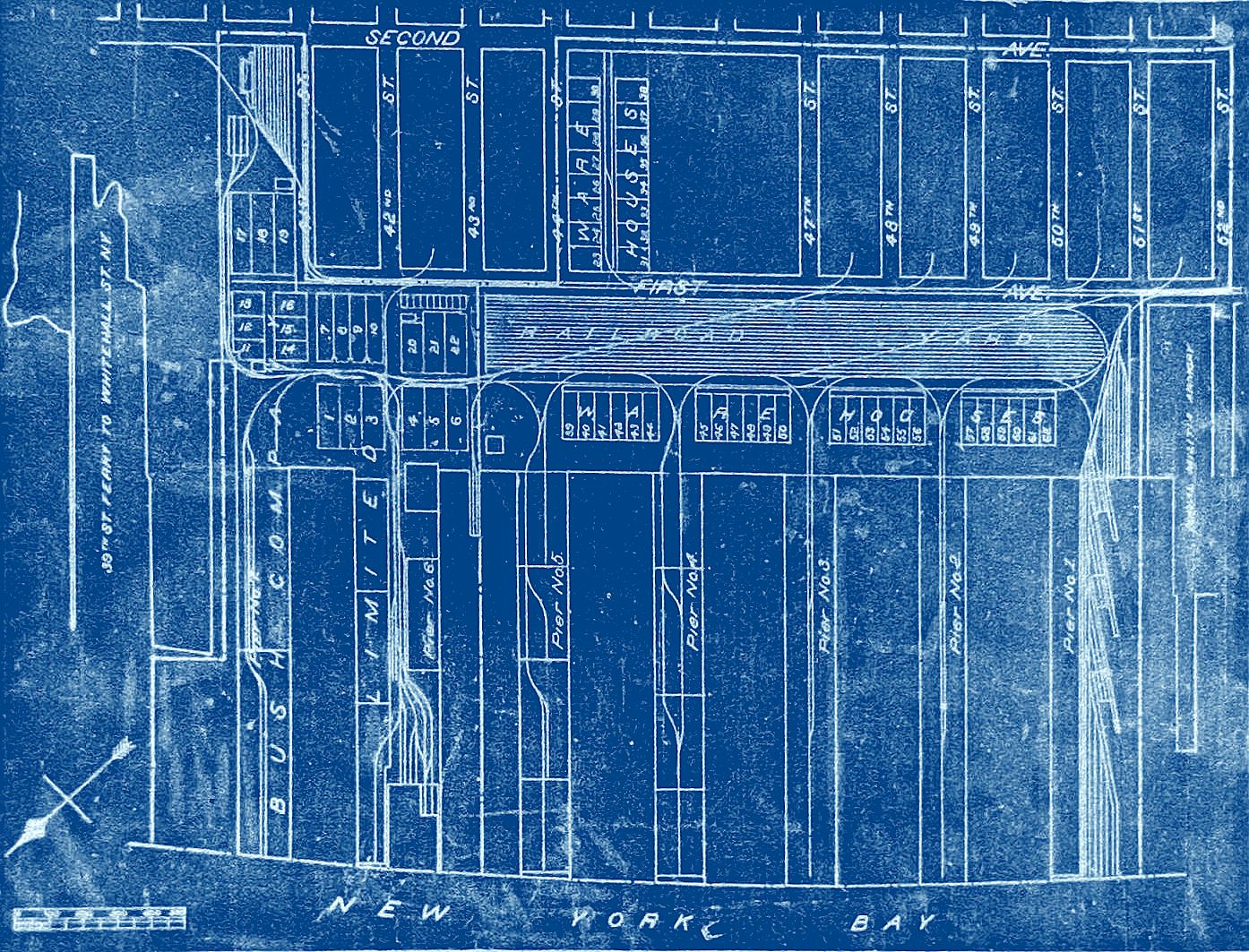
.
.
Looking south from 43rd Street - April 2, 1903
Second Avenue and Bush Terminal Railyards to left, bulkhead to right.
taken from roof of Warehouse 6
.
.
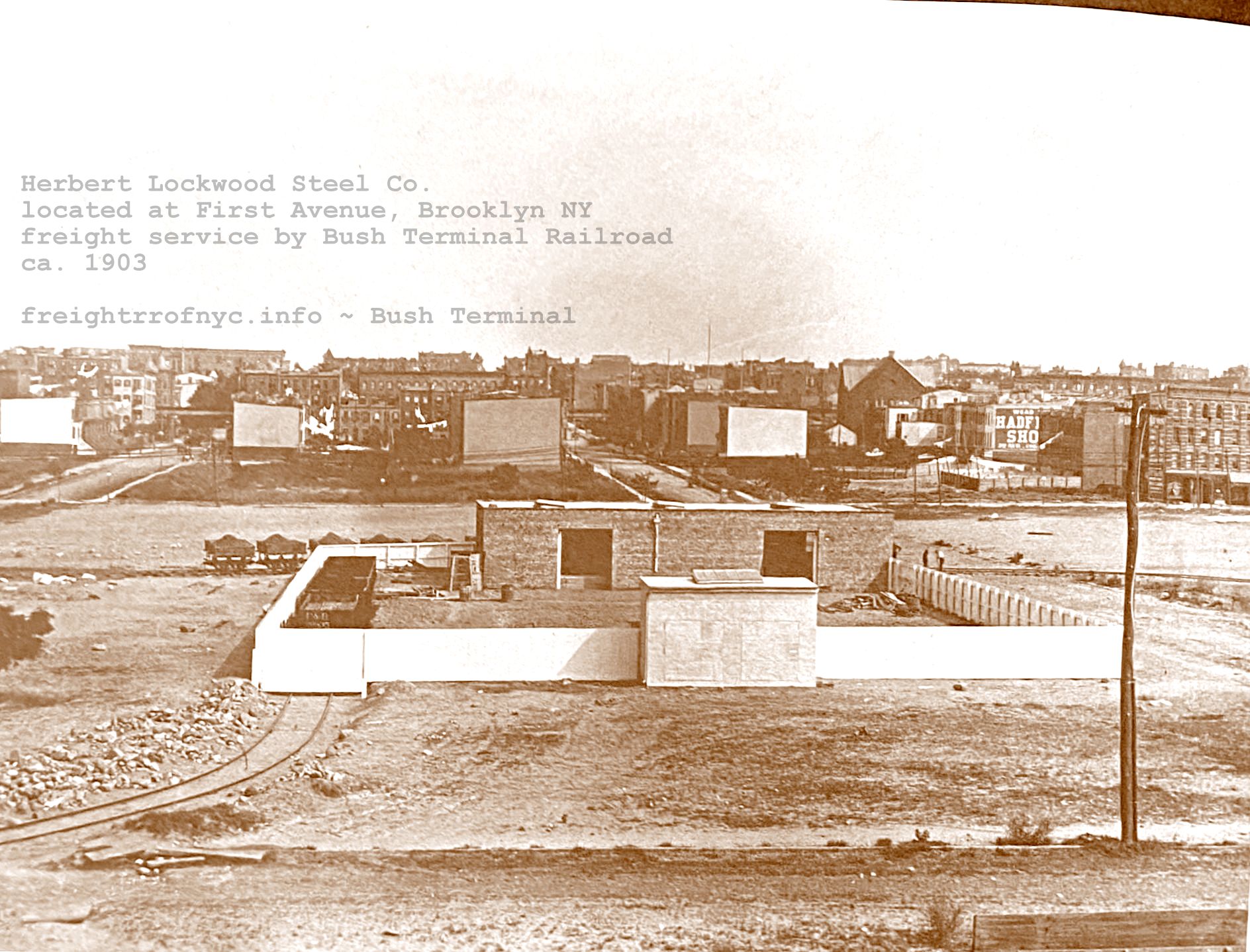
Looking east from railyard at Second Avenue and Herbert Lockwood Steel - 1903
.
.
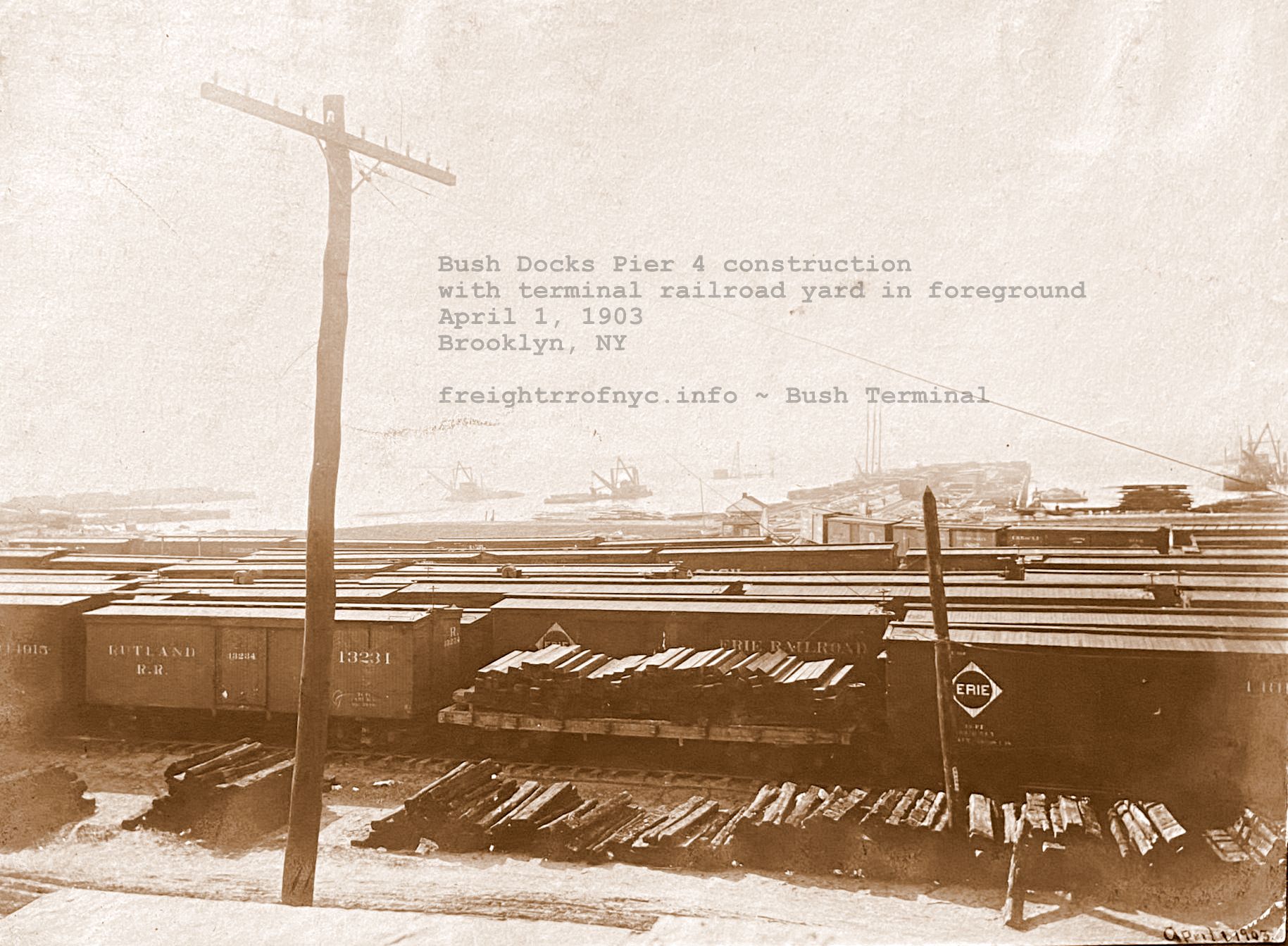
Looking west at Pier 3 under construction, April 1, 1903
.
.
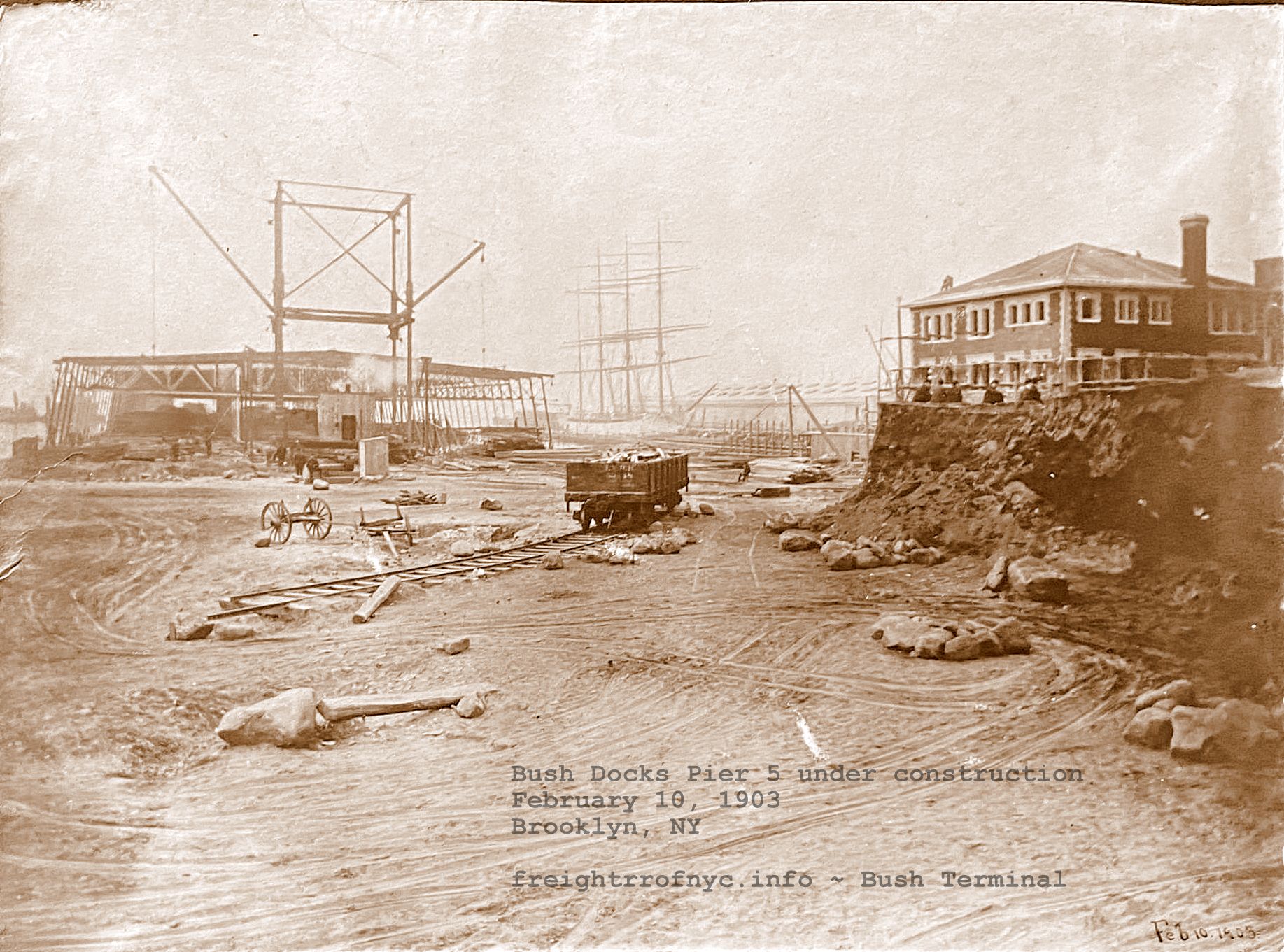
Looking west from
Second Avenue at Pier 4 under construction. Pier 5 in complete and
Bush Terminal offices at 43rd Street are being finished out - February 10, 1903
.
.
Looking west from Second Avenue at railyard at Pier 4 under construction. Three master at left is moors to Pier 3 fill
Pier 5 is complete and Bush Terminal offices at 43rd Street are nearing completion on right - April 1, 1903
.
.
Looking south along bulkhead from 42nd Street. Pier 5 to right, with Piers 4 and 3 behind. Warehouses 39-44 on left.
Boxcar on track in foreground leads to outside track of Piers 5.
.
.
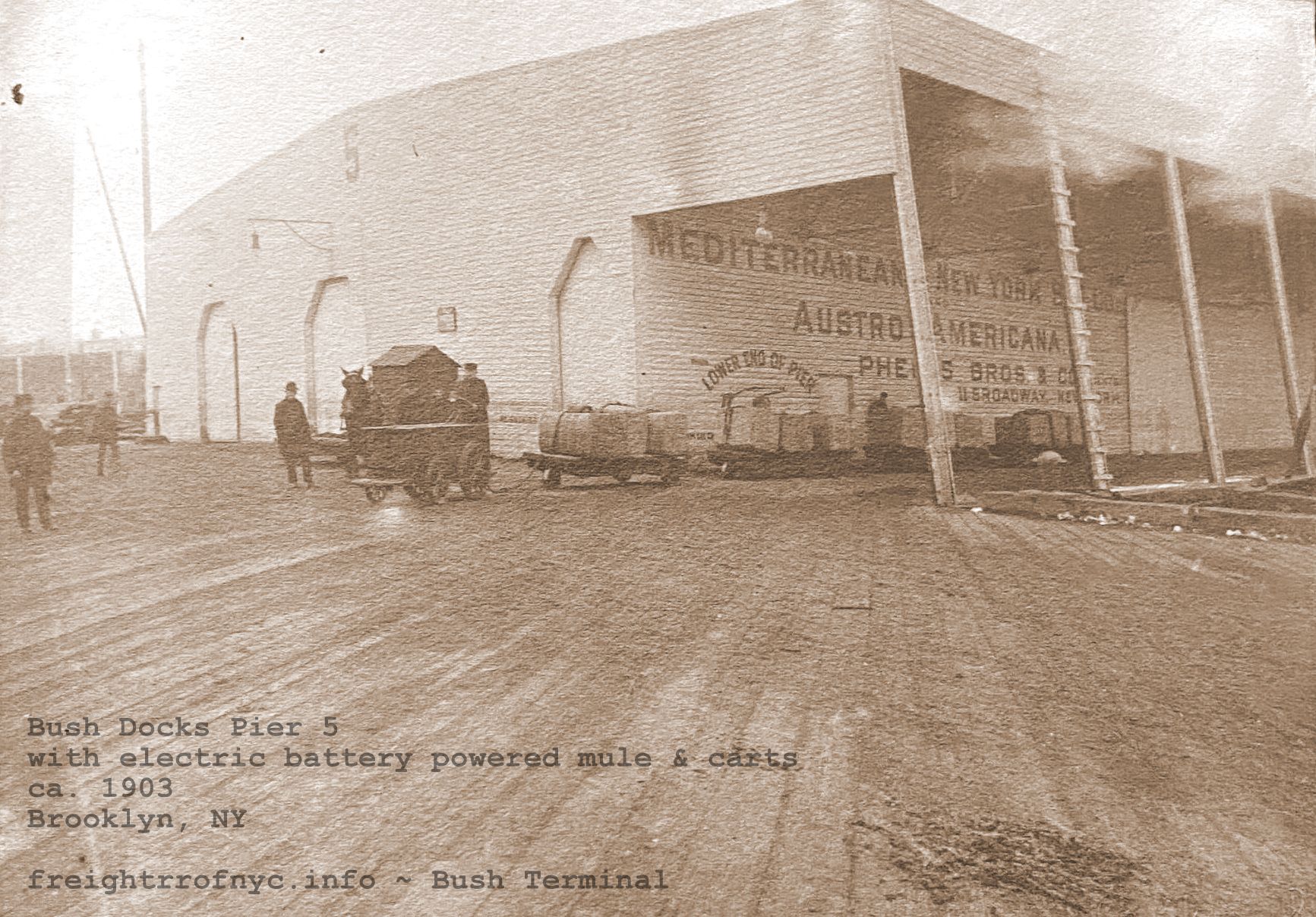
Looking southwest at front facade of Pier 5. Battery electric powered "mule" towing carts.
.
.
Bush Docks locomotive #2 on backside of Warehouses 7, 8, 9 and 10. - March 6, 1903
.
.
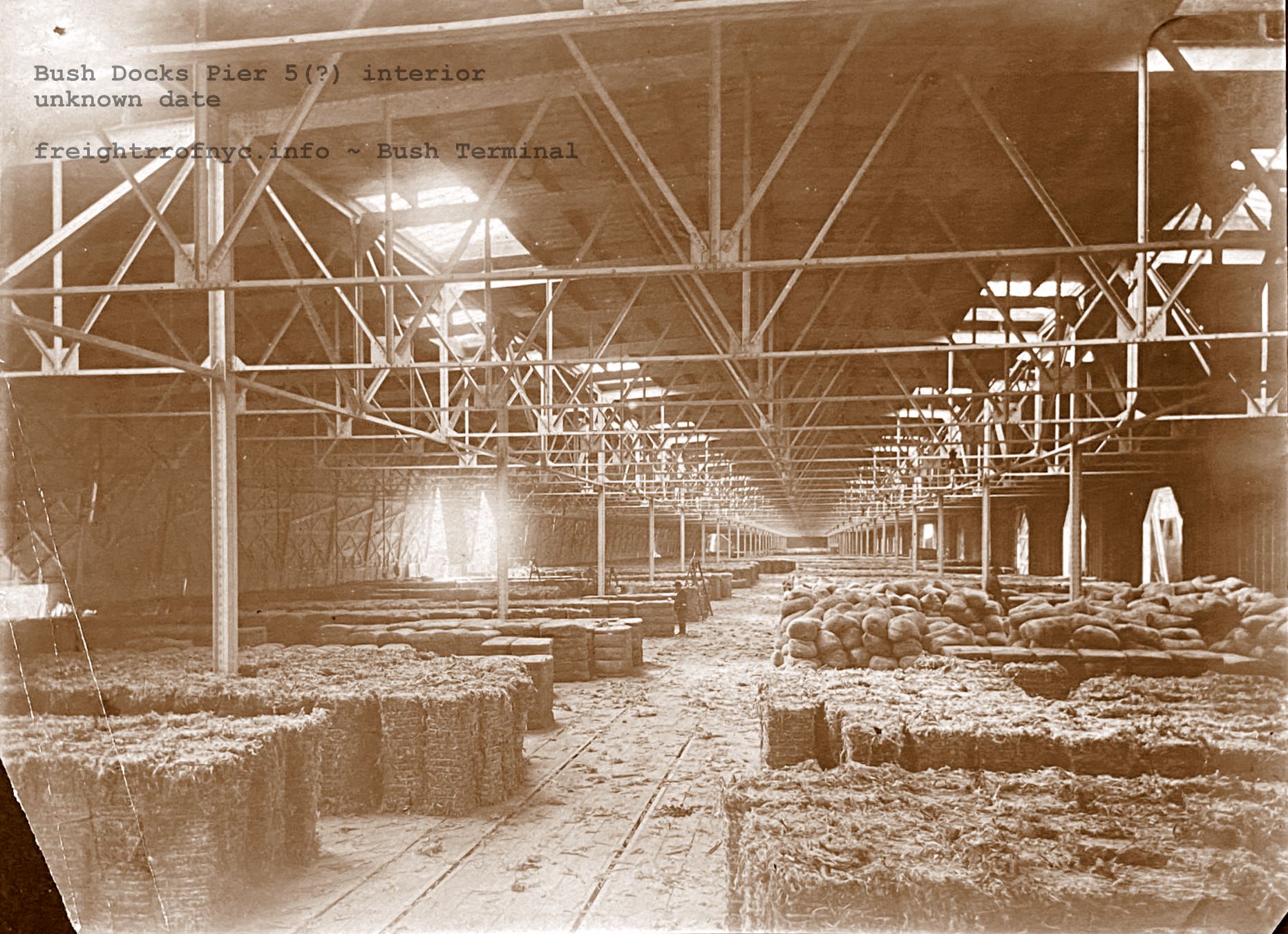
interior of Pier #5(?) - ca. 1903

interior of pier #4(?) - ca. 1903
Joe Roborecky also came across the following multi-page article in the Bulletin of the Merchants Association of New York "Greater New York" dated April 6, 1914, where it states the various terminals located in Brooklyn on that date:
Greater New York - Bulletin of the Merchants Association of New York - April 6, 1914
.
.
Paul Strubeck located some information in the following documents. The following is a summary and pier dimensions as listed in "Ports of the United States, 1916":
"The Property of the Bush Terminal Co. covers 200 acres and includes seven modern piers with an area of 1, 470, 138 square feet, 130 warehouses, 10 loft buildings for manufacturing purposes, and a terminal railroad with 25 miles of track and yard space for 2,000 cars.
The piers owned by this company are among the longest in the port. One is 1,549 feet long, four are 1,337 feet in length, one is 1,315, and one is 1,241 feet. The last named pier is 270 feet wide, while each of the others is 150 feet in width.
Four of the factory buildings of this company are 600 feet long and 75 feet wide, while 14 are 700 feet long and 75 feet wide. All are six stories in height and of reinforced concrete construction."
.Ports of
the United States, 1916
Department of Commerce - Bureau of Foreign & Domestic Commerce
Miscellaneous Series - No. 33
Report on Terminal Facilities, Commerce, Port Charges,
and Administration as Sixty-Eight Selected Ports
by Grosvenor M. Jones
.
Following is an image from the Bush Terminal section of the New York, New Jersey Port and Harbor Development Commission Joint Report with Comprehensive Plan and Recommendations released in 1920:
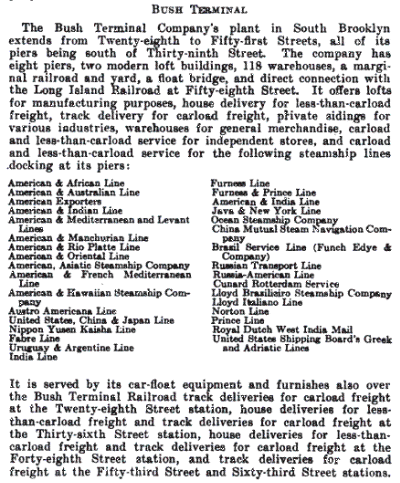
..
.
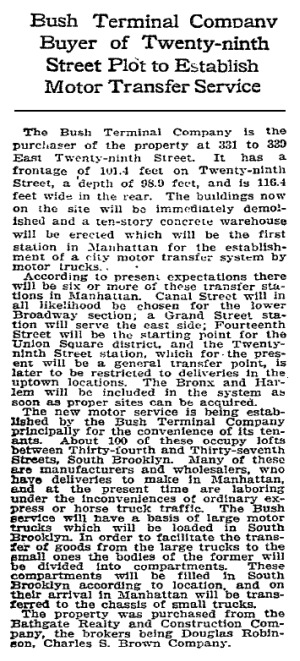 .As reported by the July 7, 1910 article in
the New York Times (seen at right), a plot of land in Manhattan was
purchased for the use as a truck transfer terminal. Please keep in mind this
is 1910, and there are not that many "trucks" per se on the roads, with those
that did exist on this date being: chain driven, on solid tires and of limited
capacity. But this "truck terminal" and the intent of construction of others
as stated in the article, is a another example of the foresight exhibited
by Irving Bush.
.As reported by the July 7, 1910 article in
the New York Times (seen at right), a plot of land in Manhattan was
purchased for the use as a truck transfer terminal. Please keep in mind this
is 1910, and there are not that many "trucks" per se on the roads, with those
that did exist on this date being: chain driven, on solid tires and of limited
capacity. But this "truck terminal" and the intent of construction of others
as stated in the article, is a another example of the foresight exhibited
by Irving Bush.
If there is anything I have taken note of in my research and compilation of data for the various independent freight terminals of the New York Area, Bush Terminal was the most well thought out and constructed freight terminal in the New York area (one book claims in all of the United States!) and it took advantage of the most modern technology in use at the time of it construction.
Time and time again, in various journals, books and references to Port Terminal construction, Public Service Commission Reports, and City Construction & Planning; Bush Terminal is held out above the rest.
In the book "City Planning - a Series of Papers Presenting the Essential Elements of a City Plan" by John Nolen, 1916; chapter XII: "Railroads and Industrial Districts", pages 264 through 278 are dedicated almost in it's entirety to the construction techniques and layout utilized by Bush Terminal.
Likewise in the book "Freight Terminals and Trains" by John Droege, 1912; in the "Waterfront Terminals" chapter; pages 235 through 238, contains photographs of Bush Terminal construction, building / track / elevator / loading dock layouts, pier diagrams among many other nuances of a terminal facility being constructed with efficiency in mind.
The Bush Terminal Company had vast property holdings, in addition to the railroad. It also owned many warehouses including cold storage and cotton storage, manufacturing facilities, its own hospital as well as its own powerplant.
As mentioned previously, there were seven piers along the waterfront to work in conjunction with the terminal. Thus from the smallest "less than car load" lighters from across the harbor, to large cargo ships from around the globe, Bush Terminal Company could handle them all and when all tallied up, Bush Terminal properties totalled well over 200 acres.
Bush Terminal was virtually its own city, and that can to be reflected in its nickname: "Industry City". Matter of fact, so total was Bush Terminal's recognition as Industry City, this name was painted in huge letters on the facade of the loft warehouses facing Third Avenue.
.
On 24 June 2010, Joe DeMay forwarded the following image to me for location identification. This took all of five seconds!
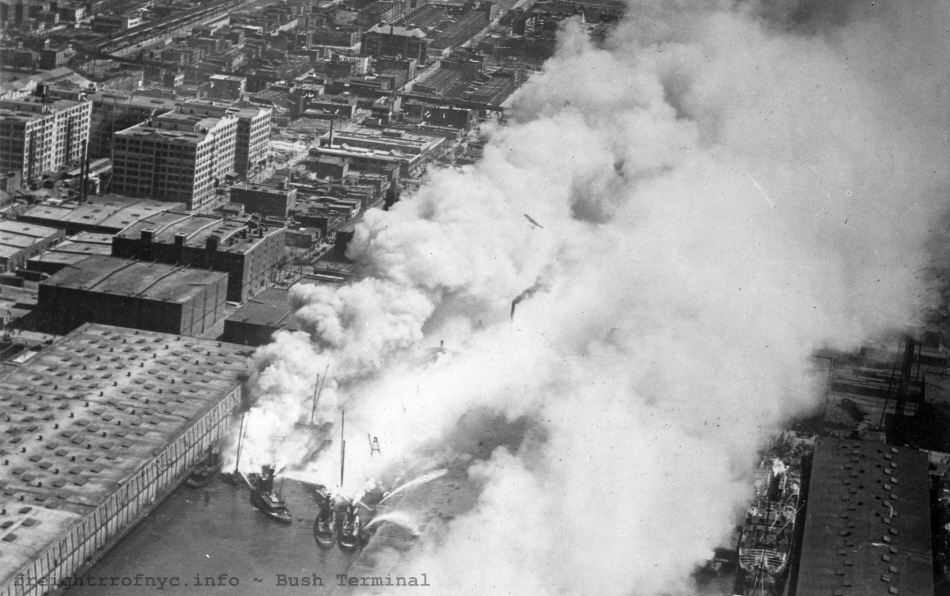
..
.
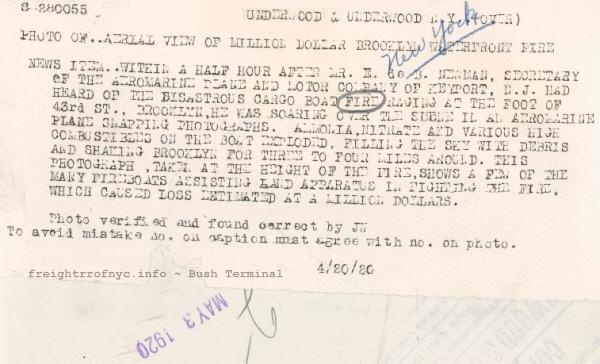
(On back of photo above)
Underwood & Underwood photo
J. DeMay collection
added 25 June
2010
.
.
So, with that, we now know that Bush Terminal Pier 5 suffered a catastrophic fire in 1920.
I located in the Library of Congress Digital Collection an aerial image of the Bush Terminal Properties dated 1958 and taken by Fairchild Aerial Survey. This image provides a good comprehensive view of the facilities just before the downtown of railroad freight traffic. Click on the image below to open the full size high resolution version. It is a huge file, so please be patient in opening. Use the back arrow on your browser to return you here.
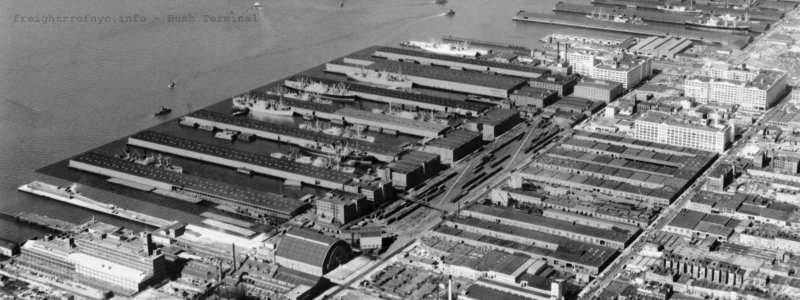
Fairchild Aerial Survey Photo - 1958
Library of Congress - American Memory Digital Collection
Historic American Engineering
Record
added 03 February 2010
.
.

Spring 1959 - "A" Yard
unknown photographer
authors collection
added 09 January 2010
.
Jay Held sent this photo, of Bush Terminal pier 1, which I have never seen before.
.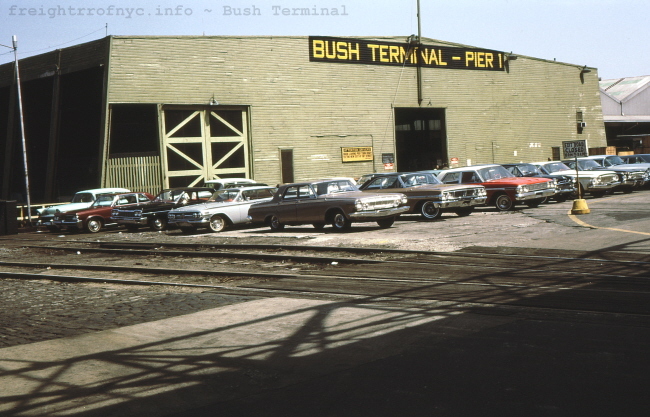
50th Street - 1965
Tracks lead to "Bush 2" float bridge can be seen in the foreground
and to left of this pier.
unknown photographer
J. Held archives
added 05 May 2009
.
.
Taking occupancy in the early 1950's and continuing through the 1960's, the Topps Company (of chewing gum and baseball card fame), produced baseball cards at Bush Terminal. Unfortunately, Topps relocated to Pennsylvania in 1965.
A real estate group led by Harry Helmsley purchased the Bush Terminal properties in 1963. Bush Terminal railroad would file for abandonment in 1971. The City of New York would purchase the property and contract with the New York Dock Company to operate the railroad in late 1971. The complex maintained 95 percent occupancy through the middle of the 1970s.
Additional information during this era of operation can be read on the New York Dock page of this website.
.
.
The following names of businesses utilized services of the Bush Terminal, whether that be receiving, shipping or leasing space; and come from several sources and publications.
.
| name | commodity | dates |
| Kirkman & Sons | soap | < 1943 > |
| Phoenix Industrial Supply | galvanized range boilers | < 1947 > |
| H. A. Thorndike | < 1944 > | |
| J. S. Woodhouse | sledge handles | < 1947 > |
.
.
Joe Roborecky forwarded the following on 17 July 2010. It is an excerpt from the "Proceedings of the Fifth Annual Convention of the American Railway Engineering and Maintenance of Way Association, which took place March 15, 16 and 17, 1904 in the Auditiorium Hotel, in Chicago, IL.:
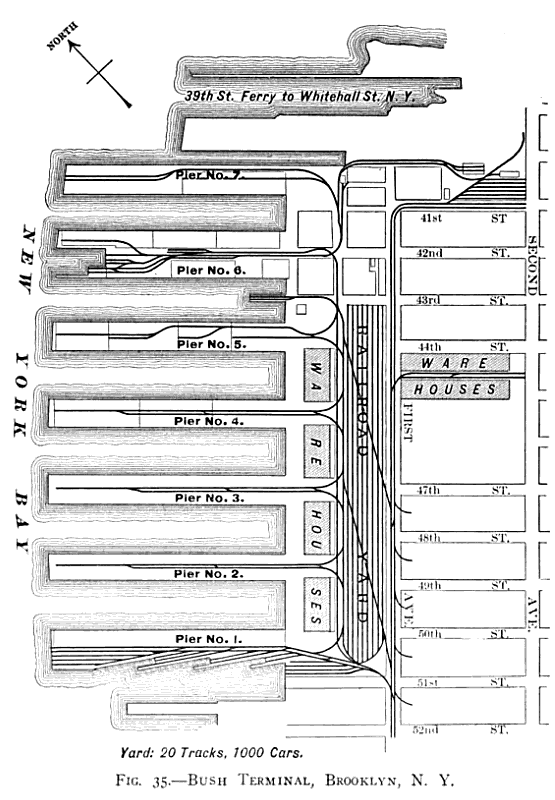
Proceedings of the Fifth Annual Convention of the
American Railway Engineering and Maintenance of Way Association, 1904
(corresponding summary may be viewed in property chapter
above)
added 17 July 2010
.
.
Note that the Report of the Railroad Commissioners below, states that Bush Terminal began laying track in July 1905. This is odd as other documents show trackage was already laid by this time. Nevertheless, the report date below, states that by July 1906 Bush Terminal had laid 2.8 miles of track, almost all of which was street trackage and with overhead electric wire and was operating one electric locomotive.
The rail laid is listed as 137 pound which is extremely heavy for that time (most was 70 pound). It is the author's understanding by reading the second report below, that this rail weight corresponds to girder or street rail (and not the typical rail so commonly found on railroads) as documented in the second report.
The following is an excerpt from the Twenty-Fourth Annual Report of the Board of Railroad Commissioners, State of New York State, Volume II, 1907, and provides greater detail:
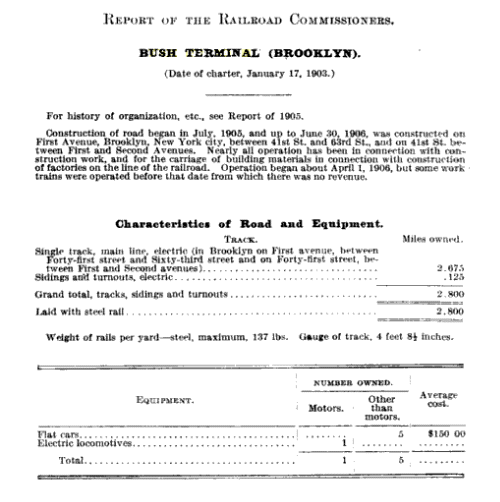
.
.
Just one year later, Bush Terminal would be operating on 3.79 miles of track with two electric locomotives, and 15 flat cars (for construction duty).
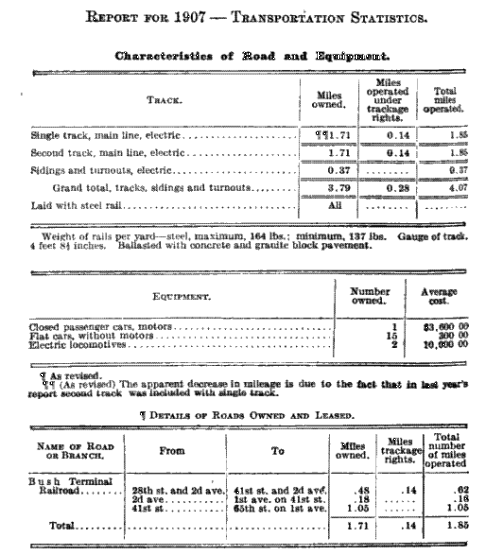
.
.
Ten years later in 1917, trackage was becoming extensive to say the least; running down no less than two main city thoroughfares with spurs running up many side streets and alleys. By this year, Bush Terminal was up to 5.72 miles of track (all inclusive) and three electric locomotives. The following is an excerpt from the Public Service Commission, First District Report of 1917:
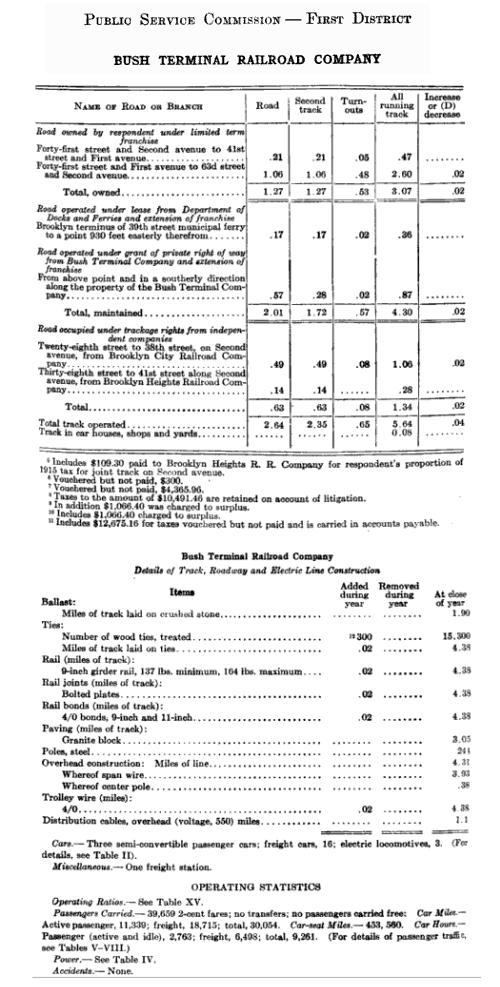
.
.
By this time, trackage would extend northward from the 65th Street yard, through the Brooklyn Army Terminal and run down the middle of First Avenue. At 51st Street, tracks would reach a turnout where the west track would veer slightly west and enter the corner of the Main Yard or the east track remained on First Avenue to bypass the yard. Entering the yard, you would come to a switch and by reversing direction would take you west and to the floatbridges.
In the yard, the track would split off into many stub tracks on both sides of two diagonal yard leads, which divided the yard neatly into thirds which can be seen in the next photo below. The westernmost leg would split off into several stub tracks that turned west to run out onto the piers and into piersheds, and other tracks would lead into buildings.
The following image is an aerial image taken by balloon; of the Bush Terminal Railyard. In the left rear corner of the yard, one can see the four dark squares of the enginehouse bays, as well as the multiple track spurs that curve off to the right of the right most yard trackage that lead into various alleys and buildings along Second Avenue, and the large white buildings of "Industry City" in the right background of the photo, which were the original manufacturing lofts served by Bush Terminal. The piers are out of picture of the left foreground.
Compare this photo with a similar one taken in September 1968 which is below.
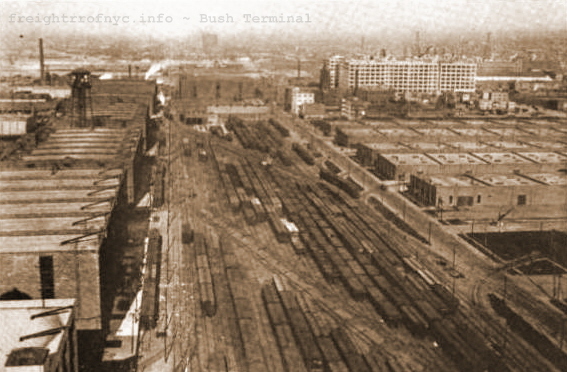
Aerial Photo of Bush Terminal Railyard (looking north)
This image was taken by a tethered hot air
balloon!
City Planning - A Series of Papers,
1916
by John Nolen
.
.

Bush Terminal Railyard (looking south)
"Many railroad freight cars on tracks in Bush Terminal Company's Union
Freight Depot at
48th Street between First Avenue and Second Avenue."
(This description is in error as this is the main yard looking south
from 43rd Street with First Avenue on the left)
E. E. Rutter photo
Brooklyn Public Library archives
.
.
Joe Roborecky also located the following property and operations pictures in the Brooklyn Public Library archives. These pictures below, should give the viewer a pretty decent perspective of the vastness of these piersheds and warehouses, when you look at the length of the train inside:
.
|
|
| .
.. |
|
|
.
.
This track would also give access to the enginehouse in the northwest corner of the yard (see photo below), or cross 43rd Street and up along a narrow street, servicing several industrial buildings. The other leg ran along the east side of the yard and stubs off this lead would turn east to cross First Avenue almost perpendicularly to run up alleys between buildings.
Either by remaining on the First Avenue main or exiting the yard out the northeast corner on the eastern yard lead would return you to street running down First Avenue. At 41st Street, the tracks turn sharply to the east to run up to Second Avenue where the tracks take another sharp turn back north. It is at this location that the tracks actually run under the corner of an industrial building, and this is a very photographed location!
Running north along Second Avenue, you encounter the interchange with the South Brooklyn Railway at 39th Street. Continuing north on the Second Avenue main track, several spurs split off and turn east into the central alleys of a series of 'C' shaped industrial loft buildings. The buildings had platforms running the length of the alley and once the cars were spotted in the alleys, these platforms would allow the loading of cars anywhere along the alley. Following is a diagram of the building and track layout as well as photographs:
.
|
|
| .
.. |
|
|
| .
.. |
|
|
.
.
.. Continuing along Second Avenue, you will eventually reach 28th Street where the Second Avenue main terminated into a small yard, which was designated a train to truck / truck to train facility. This yard was the northern most point of Bush Terminal trackage.
One of the things I admire about Bush Terminal is the unique street trackage in certain locations. To access a building alley where space was restricted, the track actually splits off the main to one side then doubles back over the main, through a diamond crossing, and then into the alley. This makes the curve into the alley more shallow, as opposed to if it would turn out into the alley directly from the main. A great deal of the Bush Terminal street trackage remains in place, and is well maintained. Most of the yard trackage on the other hand has been eliminated.
The following is US Army Corp of Engineers Port Facilities Map, 1932 edition, stitched together from two separate maps (53 and 54).
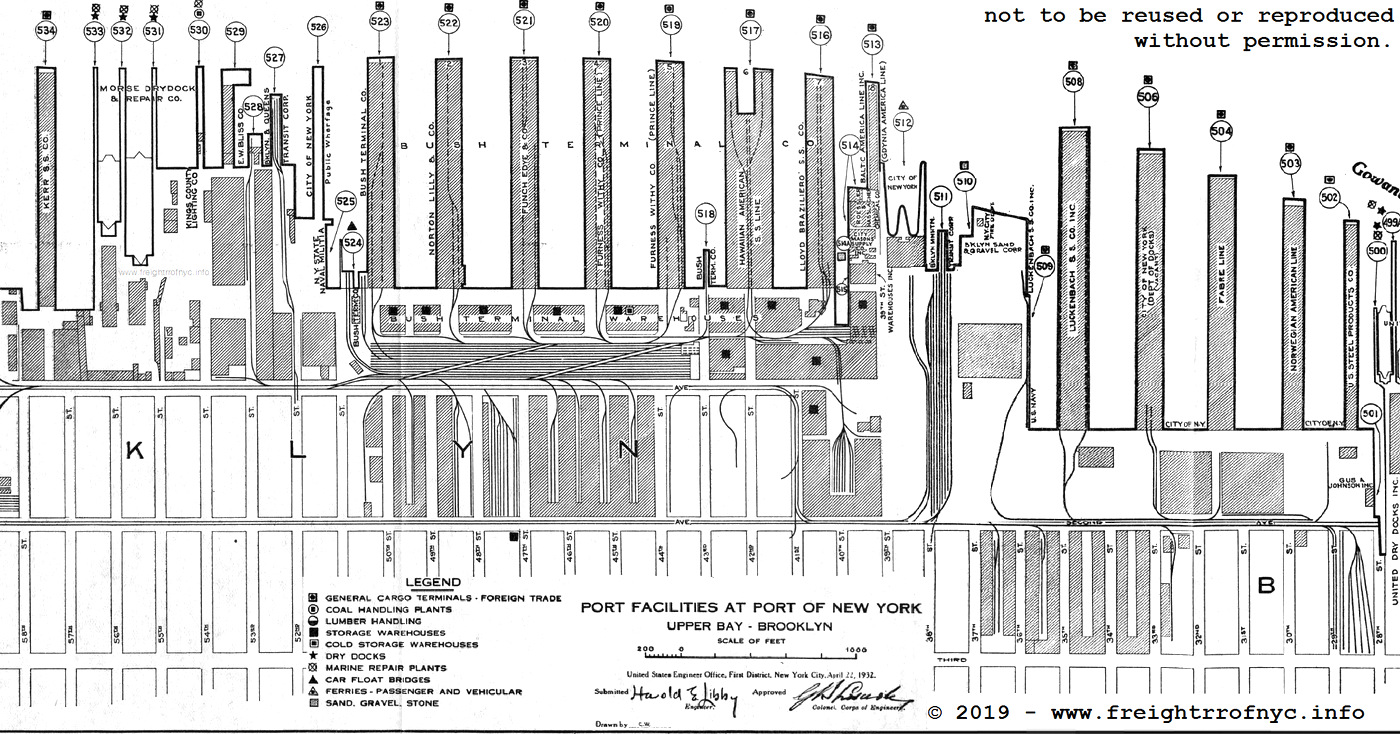
.
.
The following is the same map from the 1942 edition. This map was generously supplied by Tom Flagg. Comparison between these two maps will show changes in several areas.
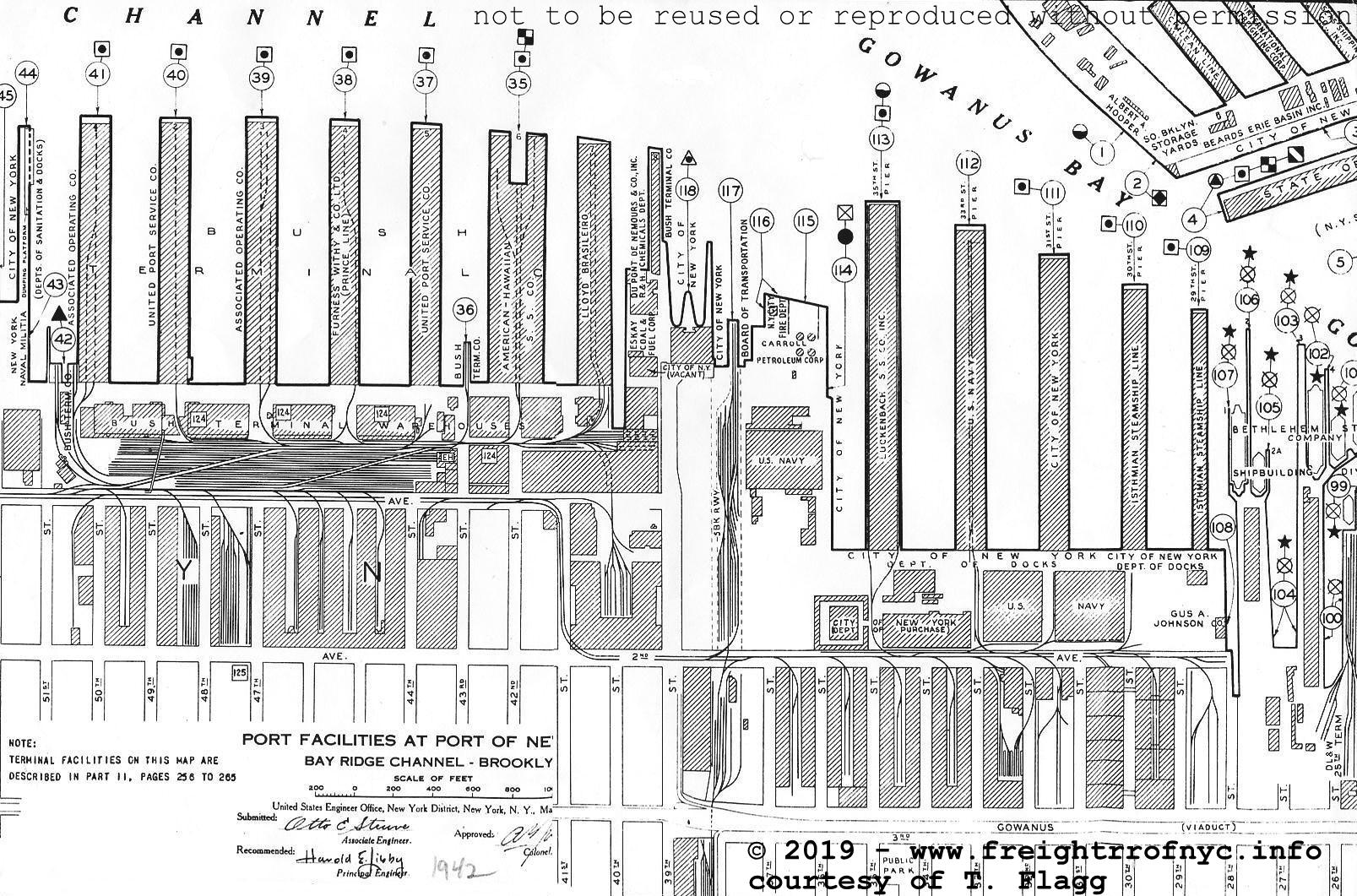
Port Facilities at Port of New York, 1942 edition
Bay Ridge Channel - Brooklyn
US Army Corp of Engineers
courtesy of T. Flagg
collection of author
added 25 April 2019
..
.
The following
map is dated January 1, 1968. Unfortunately, its provenance is not
known. Comparison between this map and the two above will show minor
changes, notably:
Please note, this map is oriented with north to the bottom left, while the Port Facilities Maps above are oriented with north to the top right.
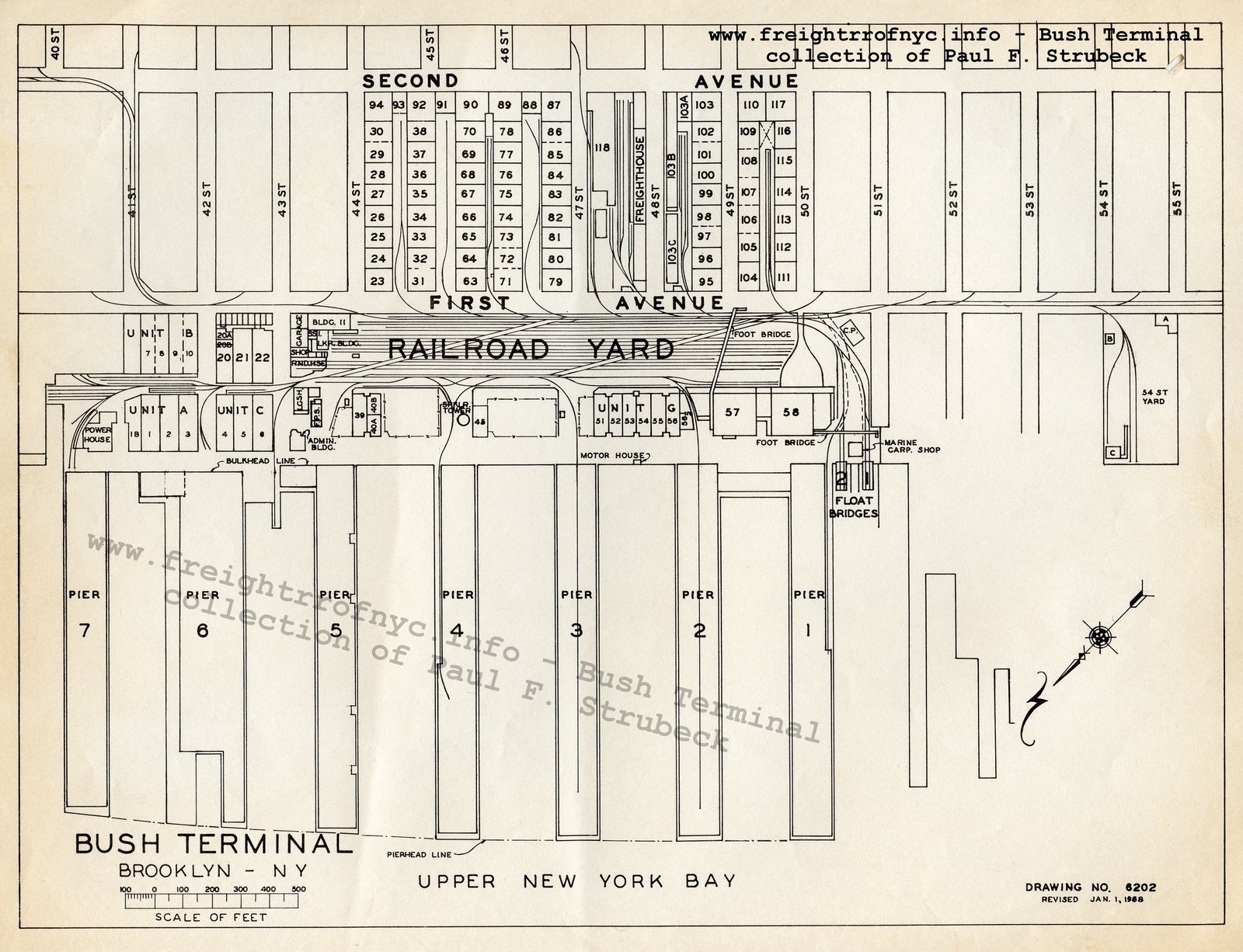
.
.
Bush Terminal had unique advantages when compared to the other three Brooklyn based independent or contract terminals (Jay Street Connecting, New York Dock & Brooklyn Eastern District Terminal).
One advantage, albeit minor; was that it was the recipient for almost all incoming freight traffic for the South Brooklyn Railway. This included both consignment freight for the South Brooklyn Railway's own customers along its route (up to 1978) as well as freight and equipment for the SBK itself and its parent organization; the New York City Transit Authority.
Bush Terminal had a distinct advantage over the other Brooklyn independent contract terminals, and that was their being able to interchange with Class 1 railroads by means of a freight line jointly owned by the New York, New Haven & Hartford and Long Island Railroads, namely the Bay Ridge Branch.
This freight line ran through the heart of Brooklyn and Queens and was known as the Bay Ridge Branch or Bay Ridge Division of the NYNH&H / LIRR and terminates at the Bay Ridge Yard at 65th Street and First Avenue in the south (adjacent to Bush Terminal) .
Northwards however, this route interconnects the Bay Ridge Yard with Sunnyside and Fresh Pond Yards in Queens (and still does to this day). At Fresh Pond Yard, an interchange existed with the New York Connecting Railroad, which utilized the Hell Gate Bridge to access the NYNH&H Oak Point Terminal in the Bronx as well as the rest of the mainland United States.
So, in all actuality and technically, the Bush Terminal Railroad was physically connected to the mainland US after 1916 (the year the Hell Gate bridge was completed).
In addition to this interchange, the Bush Terminal RR could also interchange with the South Brooklyn Railway at the South Brooklyn Railway Yard located at 39th Street on Second Avenue. The following schematic shows the connections and interchanges of the Bush Terminal RR to the other railroads in Brooklyn at the time. Please keep in mind, is it not to scale, and is a composite of the various railroads and industries that operated throughout the twentieth century, even though some of the businesses may not have existed all at the same time.

.
.
Bush Terminal was capable of handling oversize loads as well. The following image, while underexposed, shows a tall movable crane. In the image below, to the left and at the bottom of the steel legs, the Bush Terminal rail-crane can be seen in black (in a 1966 photo in non-revenue chapter below, it is beige).
The Pennsylvania Railroad gondola is carrying large blowers of the forced air / ventilation type.
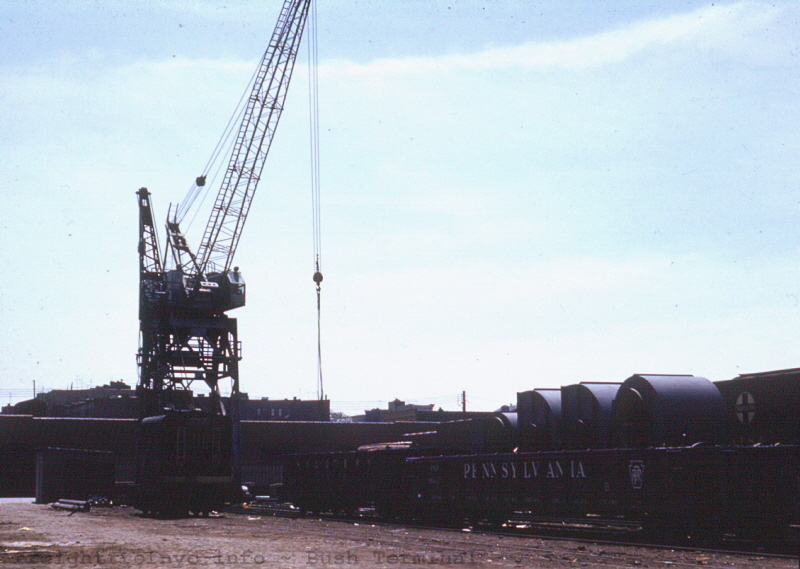
Spring 1959 - "B Yard" crane
unknown photographer
authors collection
added 01 June 2009
.
..
Now, after about an hour or so of deliberation and discussing where the crane could be located, and upon reviewing 1954 and 1966 as well as modern day aerials (to try and match buildings), Joe Roborecky and myself could not successfully determine the location. So Joe contacted Fred Breimann and within a minute, Fred informed us matter-of-factly that the tall crane was located in the "B Yard".
So, Joe & I pan over to the location, and upon looking at a 1954 aerial image on historicaerials.com, the shanty and the shadow of the crane can be discerned. But the image is so grainy, I did not feel it worth of posting here. The "B Yard" was bound by 46 and 47th Streets and First and Second Avenues with the crane located at the east (Second Avenue) end of the yard. This crane was mounted on a set of rails and movable:
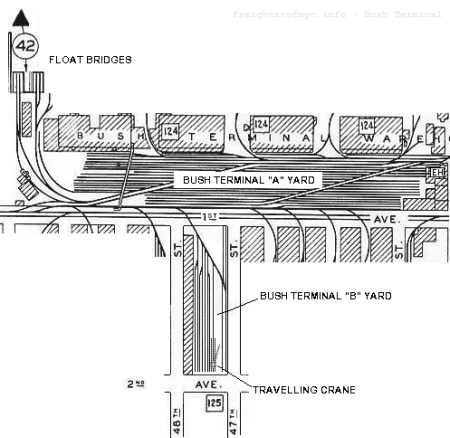
This movable crane would be removed by 1966 and a structure the length of 47th Street built upon the block.
The "A" Yard (main yard) would also receive oversized loads. My father, was present at Bush Terminal one day when this oversize load was being unloaded.
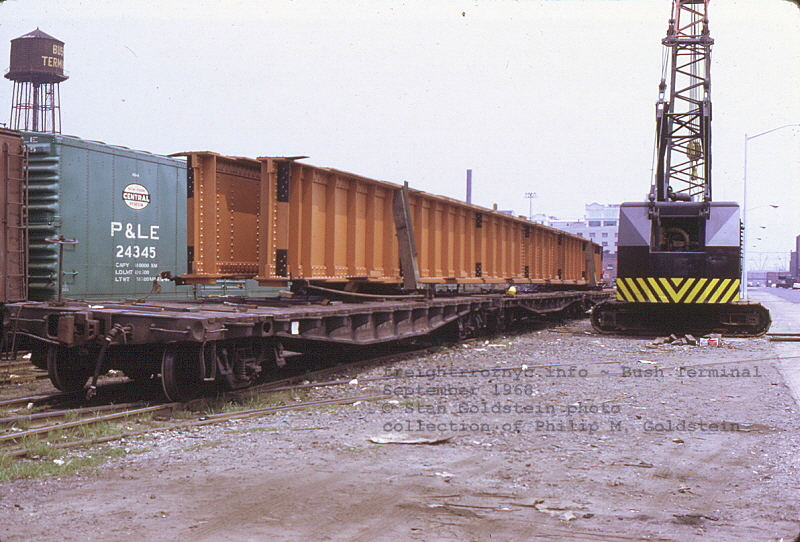 |
| . |
|
|
|
both photos: September 1968 |
.
He was told these girders were to be used in the construction of the Verrazano Narrows Bridge and that is the story he related to me. But the date on the restriction card is 1968, four years after the bridge actually opened. So, I thought they might have been used for a new arterial highway approach for the Verrazano, but not actually for the bridge itself. As it turns out they were in fact for the lower deck of the bridge, which opened for traffic in June 1969 and built after the bridge initially opened.
After the load was removed, the riggers gave my father one of the excessive dimension cards, which I found going through his collection after my father passed in October 2009. The restriction cards were affixed to the three 50' flat cars, and can be seen in the left photo above just below the end of the girder:
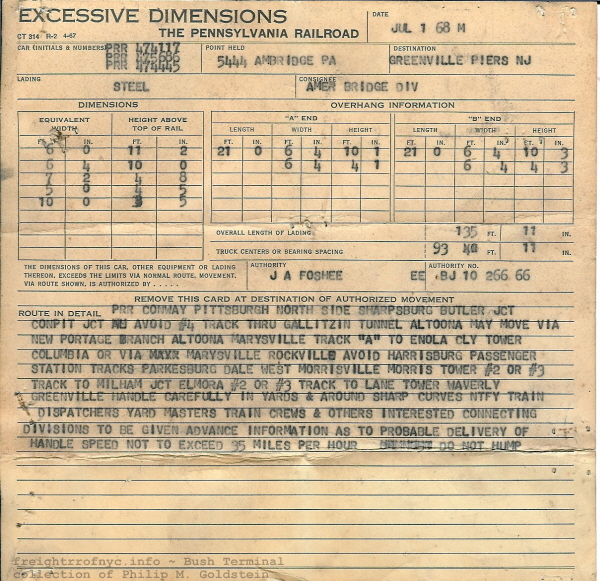
.
.
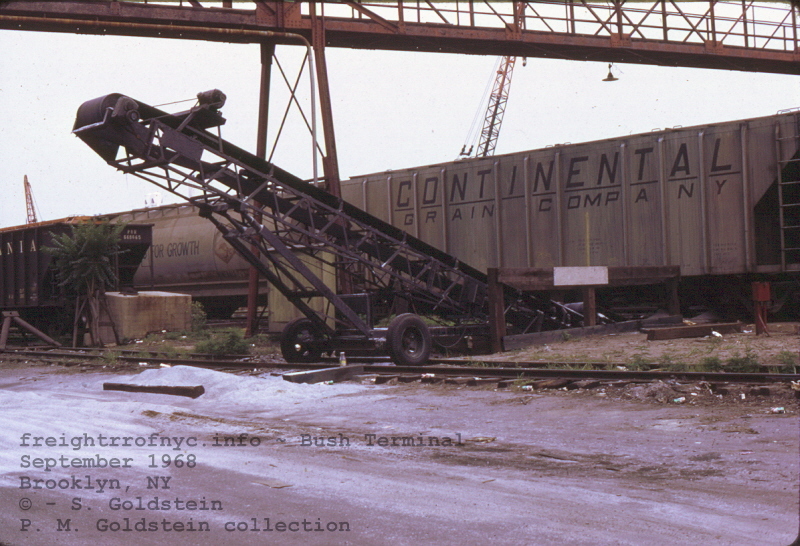
September 1968
S. Goldstein photo
authors collection
..
.
The following images is of a yard office located under the main
pedestrian bridge (not at the foot of the float bridges as originally
stated):
.
|
|
| .. . |
|
|
|
both: September 1968 .
. The next image was taken in 1958, and was taken by S. Meyers. It is now part of the Dave Keller archives who has graciously submitted it for viewing here: |
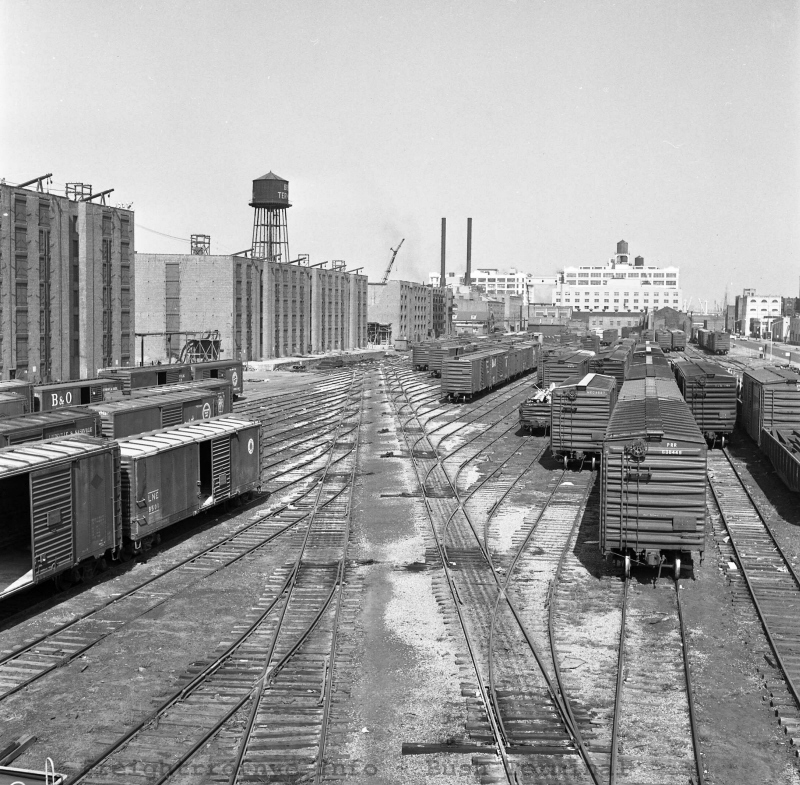
Bush Terminal Railyard (from pedestrian bridge) -
1958
S. Meyers photo
D. Keller archives
added 04 Sept 2009
.
.
Here is a photo of the Bush Terminal Yard taken in September 1968 from almost the exact same place on the pedestrian bridge, by my father Stan Goldstein. This photo like the one above, shows one of the two twin diagonal yard leads from a lower perspective than the 1916 balloon aerial above. Notice the yard is quite full. How unfortunate that Bush Terminal would file for bankruptcy only two years later.
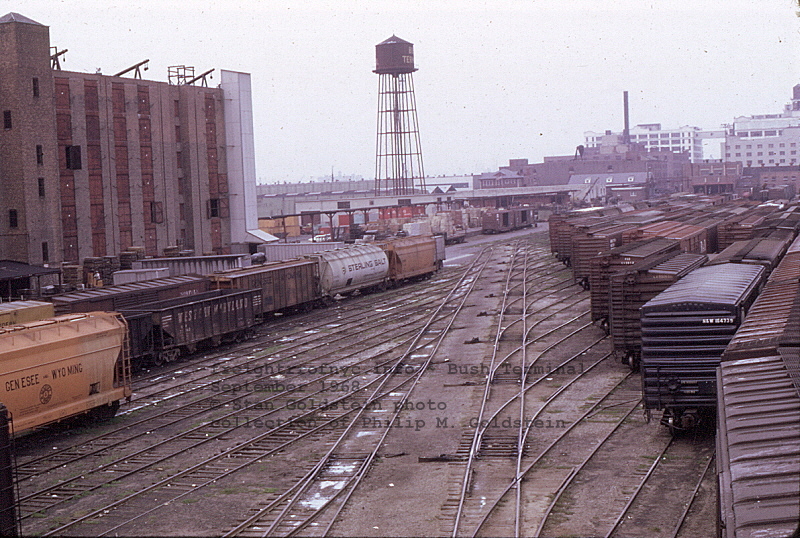
Bush Terminal Railyard (from pedestrian bridge) -
1968
S. Goldstein photo
authors collection
.
.
Fred Breimann
If you have not already reached your own conclusion, a good deal of information on this page pertaining to everyday operations at Bush Terminal (both before and after New York Dock), comes from Fred Breimann, who began his tenure at Bush Terminal in March 1947 working in the warehouses.
|
Freighthouses: |
March 4, 1947 - laid off September 1947 September 1947 October 2, 1947 June 18, 1956 December 27, 1965 |
On December 17, 1972, Fred was hired by New York Dock to protect locomotives placed on a carfloat in the Erie Basin and moored to Revere Sugar pier. The locomotives were being transferred to Bush Terminal but severe weather intervened, and they were tied up here until the weather passed. Fred was assigned to look after the locomotives until they could be offloaded at Bush Terminal. This was his first "days pay" from New York Dock.
Fred's father was also a railroad man: he was a passenger conductor out of Grand Central Terminal North (Putnam Division?) on the New York Central RR, before coming to work at Bush Terminal in 1941 as a trainman and later, a yardmaster.
It is obvious that Fred was quite instrumental to us for recalling Bush Terminal history as well as locomotive usage. Unfortunately, Fred passed away on June 20, 2017 after a long illness and took with him his experiences. Rest easy Fred.
Administration
| Cyrus J. Lawrence Frank Bailey E. T. Bedford W. N. Dykman F. J. Lisman William Shillaber R. G. Simonds H. A. Smith John C. Hilly |
Directors | < 1918 > < 1918 > < 1918 > < 1918 > < 1918 > < 1918 > < 1918 > (1953) 1956 - 1966 > |
| Chairman | ||
| Irving T. Bush E. T. Bedford, II John C. Hilly |
President | < 1918 - 1948 < 1952 > (1953) 1956 - 1966 > |
| H. H. Gardiner | Acting President | < 1906 > |
| H. H. Gardiner William Shillaber A. C. Woodruff R. G. Simonds Col. Philip Gerhardt R. A. P. Walker |
Vice-President (s) | < 1906 > < 1918 -1920 < 1918 > < 1915 - 1918 > < 1930 > < 1952 > |
| Vice President of Operations | ||
| Assistant Vice President | ||
| R. G. Simonds | Treasurer | < 1918 > |
| John A. Heinrich A. M. Woodruff |
Assistant Treasurer (s) | < 1918 > < 1918 > |
| Comptroller | ||
| Henrita F. H. Ried | Executive Secretary to Mr I. T. Bush | < 1915 > |
| F. B. Studwell Henrita F. H. Ried |
Secretary | < 1906 > < 1918 - 1920 > |
| Assistant Secretary | ||
| Auditor | ||
| General Manager | ||
| Col. Philip Gerhardt | Traffic Manager | < 1918 > |
| W. L. Sturges | General Superintendent | < 1915 > |
| George Smith | Superintendent (s) | < 1947 > |
| Terminal Superintendent | ||
| Tug Dispatcher & Terminal Superintendent | ||
_ Malin _ Fleming _ Judd |
Master Mechanic | |
| Shop Foreman | ||
| Mechanic | ||
| General Foreman | ||
| Agent | ||
| General Agent | ||
| Frank Brush Henry Briemann Charlie Kallerman ª |
Yardmaster | 1941 - 1965 > |
| Employee Labor Relations | ||
| Bessie | secty to Flaming | |
|
Employees - Marine Department |
||
|
Employees - Railroad |
||
| Fred Briemann | wiper, locomotive helper, engineer | 1947 - 1972 |
| Jim Gallagher | gen'l chairman for Brotherhood Railroad Trainman | < 1947 > |
| _. Donovon | engineer | |
| Louie Sazl | engineer | |
| _ Sauda | engineer | |
| Louis Scaglione | engineer | |
| Thomas Behan | locomotive helper / engineer | < 1972 (to New York Dock) |
| _. Kennedy | brakeman / conductor | |
| _. Hunt | brakeman / conductor | |
| J. Toohey | conductor | < 1972 (to New York Dock) |
| Bill Malin | engineer | |
| Jack Wallace | engineer | |
| _. Rockowski ª | engineer | |
| Pinkler | engineer | |
| Hunnicut | brakeman / conductor | |
| Hempstead | engineer helper | |
| _. Frankiln | hostler | |
| _. Justice | hostler | |
|
Employees - Shop / Maintenance |
||
| _. Von Glon | wiper | |
| Joe Climbers ª | wiper | |
|
Employees - other |
||
ª = spelling may be incorrect
|
Bush Terminal as originally constructed, was equipped with a single float bridge. This float bridge was of wooden Howe Truss design, common to that era. Thanks to research by Tom Flagg, previously published in Transfer Issue #37; this float bridge was located at the end of Bush Terminal Pier 6 and this float bridge was at this location from circa 1900 through 1912. This is an unusual location, as to current knowledge every other float bridge in use around New York Harbor was mounted along the bulkhead. An aerial photo (taken tethered hot air balloon and seen at right).
|
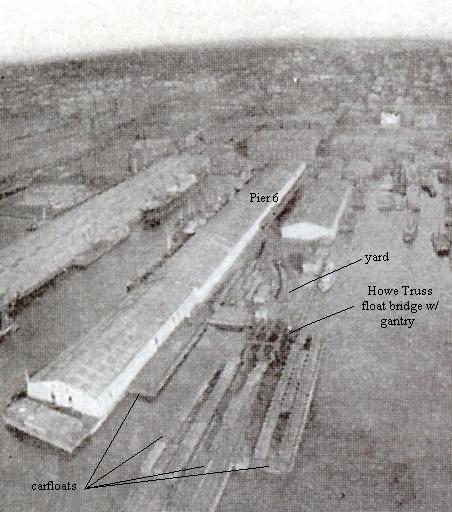 |
|
|
Pier 6 - 1911 - looking east |
.

Pier 6 with Howe Truss float bridge and gallows - circa 1910 - with BT Carfloat
#8
A. Moore / E. E. Rutter photographer
Culver Service collection
authors collection
added 13 August 2016
.
Around 1912, when the present location of the current float bridges was selected at the foot of 50th Street, and those float bridges constructed, Pier 6 would be reconstructed into a closed piershed with internal trackage, but without a float bridge:

1912 - 1971
Pier 6 as reconstructed without float bridge
U.S. Engineers Office, NY District - 1942
authors collection
added 12 Nov
2009
.
The "new" location for the two float bridges which were constructed at the foot of 50th Street. They were positioned side by side with approximately 50 feet of space between them:
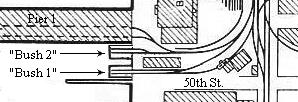
1912 - present
U.S. Engineers Office, NY District - 1942
authors collection
added 12 Nov
2009
.
According to Tom's research, these two float bridges were originally wooden Howe Truss type as well. By referencing the photograph below in the Marine chapter (showing the sunken carfloat and of which is dated April 21, 1961); we can see that the "dockworker" is standing next to the winch mechanism, which is mounted to some tall reinforced timbers. This is undoubtably a Howe Truss float bridge.
While it is clear that the Howe Trusses were in service in 1930 (by referencing the Fairchild Aerial Survey photo), it is remarkable that they were still in service as late as 1961.
This is a rather significant fact (at least to the author), as New York Dock, Brooklyn Eastern District Terminal and even the Jay Street Terminal had already been utilizing steel float bridges of pony truss and pony plate girder design.
According to Fred Breimann, he recalls that when it was required to "tighten" the Howe Truss float bridges, a crane would be situated at the bulkhead with the boom out and over the pontoon end of the float bridge. Cables would be affixed to the outer end of float bridge, and the crane would raise the float bridge slightly. Workers would then tighten the nuts on the vertical rods going through the tops of the wood trusses.
According to Tom Flagg, the Howe Truss design worked with compression, tension and torsion. By tightening the nuts, this would both compress and apply tension on the trusses as well as reduce any torsional stresses incurred upon the float bridge during rail operations and thereby keep the float bridge weight capacity up to specification.
By 1963 however (as shown in a few photos below), the Howe Truss float bridges at Bush Terminal had already been replaced with steel pony plate girder float bridges and of which can be viewed in quite a few of the photos. Tom Flagg submits this info which was previous published in the RMIG Transfer #37. At least one of these float bridges was recycled from elsewhere according to Tom Costello a Bush Terminal / New York Dock employee Tom Flagg interviewed in 1975.
The float bridges, by the way, are referred to as "Bush 1" (the southern bridge) and "Bush 2" (the northern bridge).
Upon New York Dock's takeover of Bush Terminal properties in 1972, there would be significant changes to the float bridges, so I ask you refer to that page on this website for the histories and current images of the float bridges during that era of operations: New York Dock.
.
READERS PLEASE NOTE:
The Equipment Rosters & Photographs for Bush
Terminal Railroad Locomotives, Non-Revenue Equipment & Marine Equipment
have been moved to their own page to facilitate faster loading of this main
page.
Here is a link to the Rosters / Photo page:
.
Bush Terminal Railroad - Locomotive, Non Revenue & Marine Equipment: Rosters & Photos
.
.
.
|
|
| .
. |
|
|
| .
. |
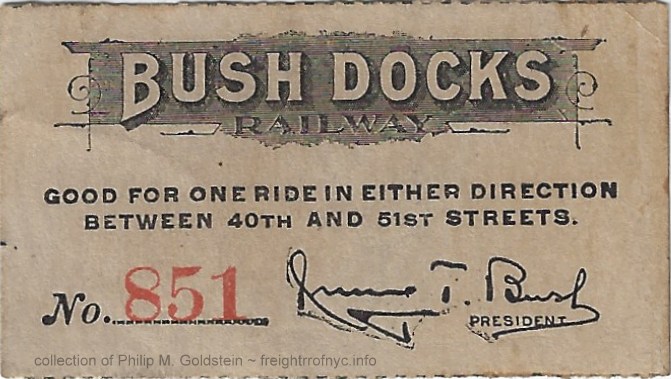 Bush Docks Railway - unknown date Presumably for the very early passenger service before trolley. facsimile signature of Irving T. Bush authors collection 1 3/16" x 2 1/8" added 07 May 2023 |
| .
. |
|
|
|
|
| .
. |
|
|
| .
. |
|
|
| .
. |
 Form 371A - September 19, 1929 8 1/2" x 11" authors collection added 02 March 2022 |
| .
. |
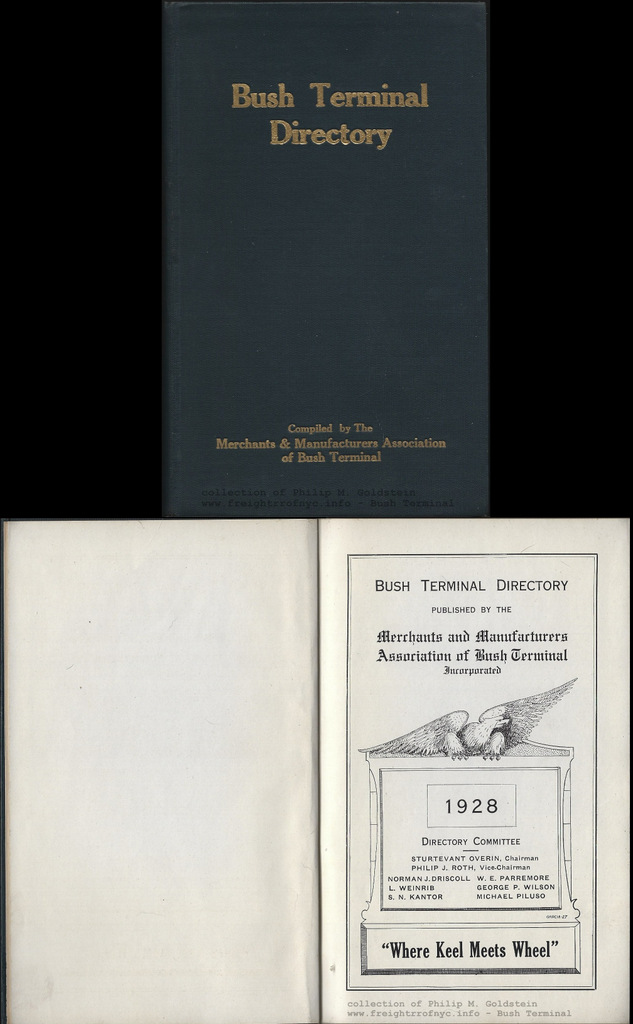 Bush Terminal Directory - 1928 5" x 8" authors collection added 02 March 2022 |
| .
. |
|
|
| .
. |
|
|
| .
. |
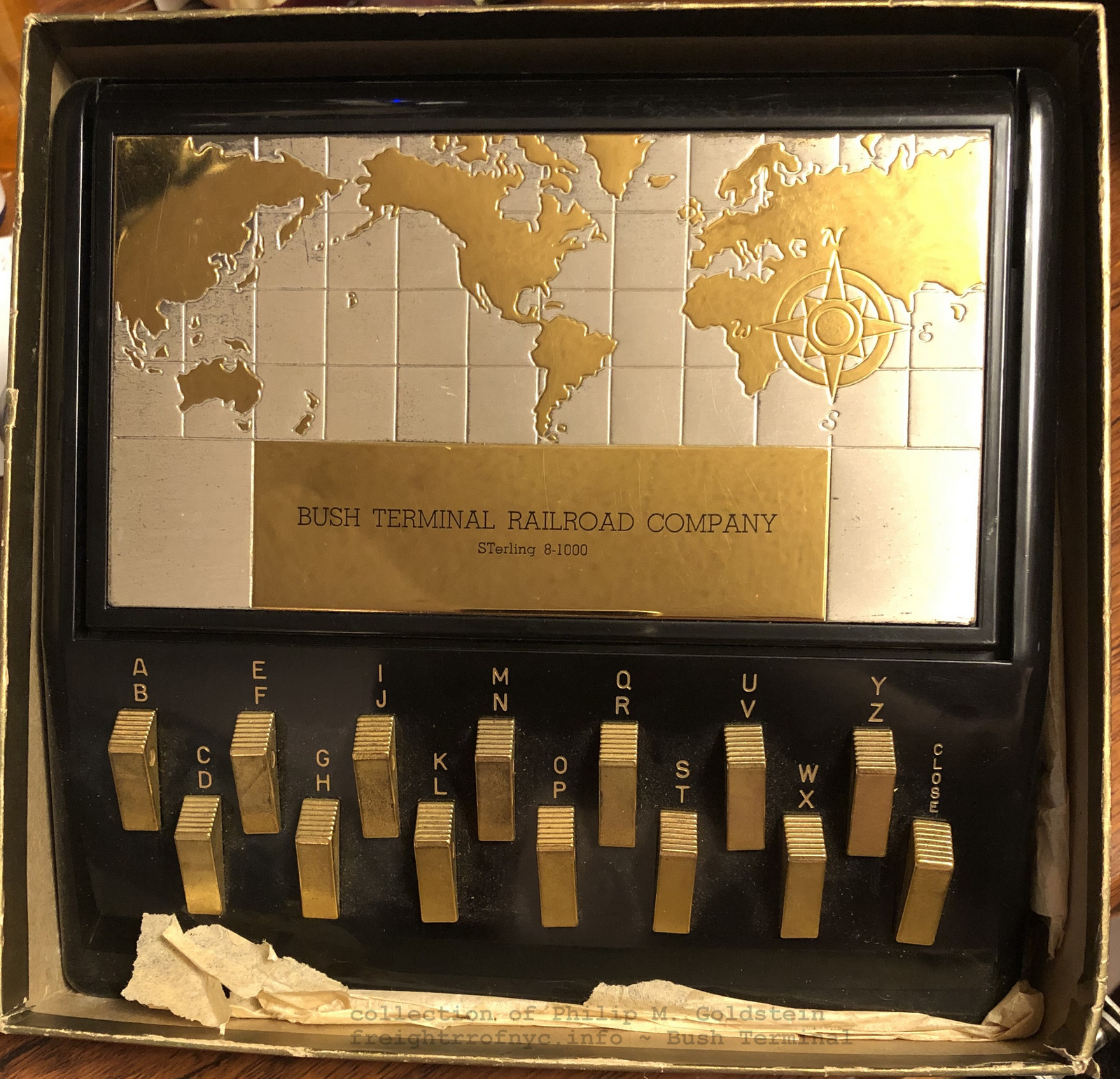 Brown & Bigelow telephone index - ca. 1960's authors collection added 09 January 2023 |
| .
. |
|
|
| .
. |
|
|
| .
. |
|
|
| .
. |
|
|
| .
. |
|
|
| .
. |
|
Of the following stock certificates, two varieties are known. It was
originally thought that both were for investors in the United States, Therefore, it is now believed that the stock issues with the allegorical figure "variety 1", are domestic issues for investors in the United States.
Issues with the shipping vignette (ship & locomotive) "variety
2"are believed to be for investors located overseas,
|
| .
. |
|
|
| .
. |
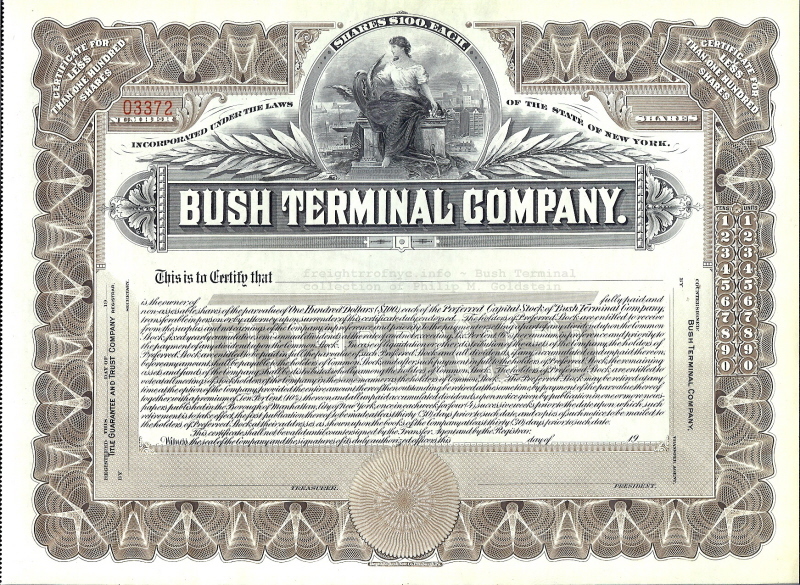 Stock Certificate, preferred shares, less than 100 shares, domestic issue?, unissued - undated. authors collection added 22 Jan 2009 |
| .
. |
|
|
| .
. |
|
|
| .
. |
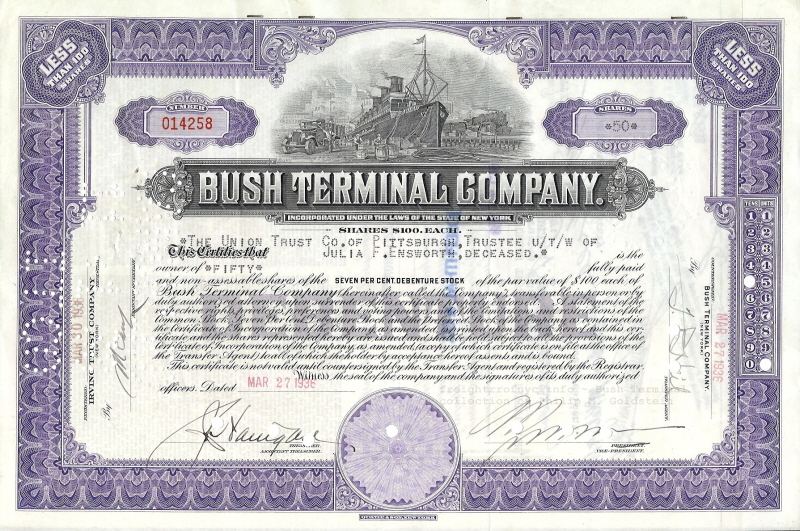
Stock Certificate, debenture shares, less than 100
shares, variety 2, issued 1936, cancelled1938 |
| .
. |
|
|
.
.
.
Like what you see? Suggestions?
Comments?